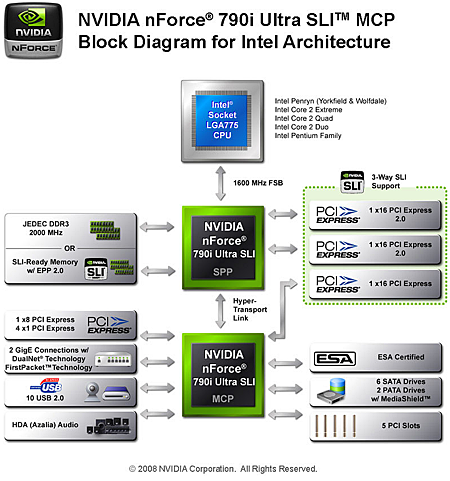790i Ultra SLI Motherboards Compared
Nvidia Makes Chipsets?
There’s no arguing against the superior performance of Intel’s current crop of high-end desktop processors, but experienced builders often prefer a high-end Intel chipset to go with them. Yet for several years graphics giant Nvidia has held support for SLI technology as its one competitive advantage over Intel in the chipset market. It’s not that Intel chipsets aren’t capable of supporting SLI technology — it’s just that Nvidia has chosen to reserve this feature for its own platform products, by artificially restricting platform support in its graphics drivers.
By staying on top of the graphics market for most of the past few years, Nvidia has been able to force its SLI chipsets into the systems of high-end gamers. Reserving SLI for itself ensured that the brand’s chipsets didn’t need to be great, as even basic functionality would allow gamers to excuse minor platform shortcomings as they eyed the added gaming performance of SLI.
And thus began the legacy of the mediocre nForce 4 SLI Intel Edition, the nForce 500 series that was so problematic most motherboard designs never reached production, and finally, the nForce 680i, which brought Nvidia back up to its previous mediocre standards. A bit of information that Intel had held back from Nvidia prevented original 680i motherboards from supporting 45 nm Core 2 Quad processors, so Nvidia added the 780i to its product line, which was nothing more than a 680i with a separate PCI Express 2.0 bridge added.
Nvidia’s history left us expecting little in the way of improvements from its 790i series chipsets. But we were in for a surprise. In spite of its antiquated 90 nm production process, the new northbridge features a fully modernized design.

The 790i series northbridge includes support for 32 PCI Express 2.0 lanes, 1600 MHz FSB processors, and high-speed DDR3 memory. The southbridge technology is a bit more dated, providing one x16, one x8 and four x1 PCI Express pathways, along with all the traditional I/O trappings. The southbridge is likely none other than the firm’s two-year-old nForce 570 SLI one-piece chipset for AMD processors, as both AMD and Nvidia use the same HyperTransport technology.
Officially supporting memory speeds up to DDR3-2000, the 790i Ultra SLI appears to be identical in every other way to the DDR3-1600-supporting 790i SLI. Both versions can be clocked upwards or downwards to support all speeds of DDR3 desktop memory, but the possibility that the better-rated parts are “speed binned” will keep the wealthiest enthusiasts buying whatever Nvidia says is best.
Today’s comparison includes every 790i Ultra SLI motherboard on the market, and we went still further by gaining access to one motherboard that isn’t even available to consumers. So how many motherboards exist, and how well does Nvidia’s latest technology compare to Intel’s popular X48 Express? Let’s take a closer look.
Get Tom's Hardware's best news and in-depth reviews, straight to your inbox.
-
Crashman This was ALL OF THE AVAILABLE 790i Ultra SLI MOTHERBOARDS: Other graphics brands with NVIDIA reference boards INCLUDING EVGA are selling the same unit as XFX, even with the same BIOS (except for the boot logo). XFX was the only one who cared to send one.Reply -
giovanni86 Thats what i was going to say!!! Thank god. Well i guess i made the right choice. XFX 790i, exactly what i am going to buy in the coming month. Just need to save for it XD.Reply -
jaragon13 Who would pay four hundred dollars,when you can just buy a P45 for 100-150 dollars which has roughly the same real world experience as an X48 or 790I?Reply
Nah,I'd rather buy better and more reliable parts-such as power supply,processor,GRAPHICS CARD,and maybe go buy a rifle :P -
kitsilencer $400 for a motherboard? What the hell is wrong with the X48 Express that people would rather consider buying a 790i? And it can't be because of SLI. Makes more sense to buy the X48 and Crossfire.Reply -
Crashman jaragon13Who would pay four hundred dollars,when you can just buy a P45 for 100-150 dollars which has roughly the same real world experience as an X48 or 790I?Nah,I'd rather buy better and more reliable parts-such as power supply,processor,GRAPHICS CARD,and maybe go buy a rifleReply
If you want SLI you're going to need an SLI motherboard. The article specifically stated that the reference design motherboard was almost as good in many ways as the winning board, but far cheaper.
The site only has two awards, one is for top value and the other is for "best of the best". It's hard to award a $350 motherboard for top value, but it's not so difficult awarding the "best of the best" even if the price is outrageous -
Crashman kitsilencer$400 for a motherboard? What the hell is wrong with the X48 Express that people would rather consider buying a 790i? And it can't be because of SLI. Makes more sense to buy the X48 and Crossfire.Reply
It does! Well, sorta. If you want the absolute fastest rig on the planet, you're going to need at least two, possibly three, GTX280's. But if you can wait a few days or maybe a couple weeks, you might be surprised at how well a Crossfire set of HD4870X2's can perform using an X48 motherboard. -
jaragon13 My point is that,even though you could theoritically have 3/4 GPU's all at once,you won't get nearly as much performance as you'd want.A simple 750I or P45 chipset will do nearly the same job.Reply -
zer00000 It is a foxconn board i bet.I just read a review elsewhere with same stuff except it had an x48 chipset."All manner of goodies are bundled with the Black Ops: a 120MM fan, a plastic dry ice cooling pot for the Northbridge, and a Plexiglas "benching table" for open-air use."Reply
